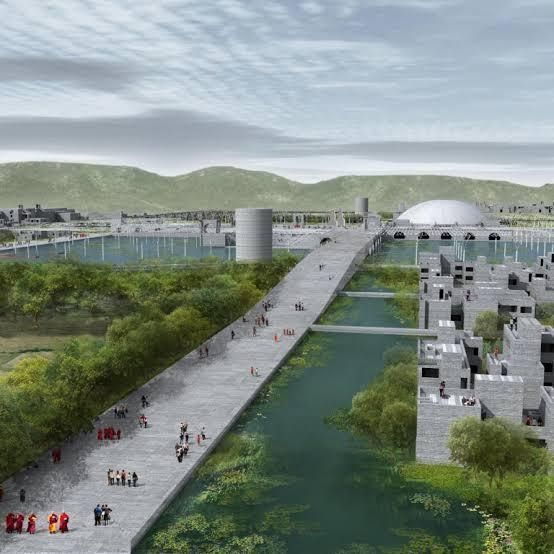An Exemplary Water Performance: Nalanda University

Water is one of the precious natural resources on the Earth. Our Earth is also known as the blue planet because water covers 71% of the Earth’s surface. The Earth has an abundance of water but unfortunately humans can use only about 0.3% (Source: National Ground Water Association, USA). The remaining percent is in the Ocean (97.2%), glaciers and other ice (2.15%), ground water (0.61%), fresh water lakes (0.009%), inland seas (0.008%), soil moisture (0.005%), atmosphere (0.001%) and rivers (0.001%).
Water scarcity has become a severe problem in many countries due to over-exploitation. Many Indian cities such as Chennai, New Delhi, Bangalore & Hyderabad would unfortunately run out of groundwater quite soon.

Thus, there is a necessity to understand these impacts and redefine the way water is being consumed in our daily life. One step to mitigate such severe impacts is through awareness and setting up an example on how every drop of water can be saved. How about having both of these in one place?
Yes! as per the sustainability design team, the initiatives adopted in upcoming Nalanda University in Rajgir, Bihar help the facility to consume zero water from municipal supply. The international fame University has set an example to fulfil all the water demand through natural ways such as by harvesting rain water and utilizing every drop efficiently through water fixtures having water flow rate lesser than 6 litre per minute. The University has also set a target to achieve GRIHA – Large Development (LD) Rating from the Green Rating for Integrated habitat Assessment (GRIHA), the Green Building Rating Certification Agency.
The University site lies in the flat Gangetic floodplain located adjacent to the Rajgir hills, Bihar. The average annual rainfall of this area is about 1075 mm, maximum of which (about 80%) occurs during June to September.

Runoff from Rajgir hills enters the site and continues downstream which floods the site. The concepts of Ahar & Pyne were developed from traditional Ahar and Pyne system which were observed on the site. After analysing the terrain and flooding pattern of the site, the artificial Ahar and Pyne has been designed and the concept of natural gravity system has been followed to reduce energy requirement to transport the water. These Ahar and Phyn will collect, store rainwater for the use throughout the year.
These Ahar and Pynes also hold and channelize upstream water towards downstream channels. Thus, protects the site from flooding & maintain stream flow for downstream users. A wide storm water line is designed on the outer boundary of the site to collect rainfall from hills and bypass the downstream to manage storm water falling on the site during heavy monsoon.

Nalanda University will source all of its demand from rainfall falling on the site and treated water from Sewage treatment plant (STP). The surface water will be collected from the roof, paved areas, green areas and water bodies.
The water balance diagram shown in Figure 6 presents the completes water cycle including the source and discharge points. Runoff generated from all the other surfaces in built areas shall be assimilated in Kamal Sagar (a large water tank at the centre) and its balancing tanks via a system of open and piped drains. Runoff generated in remaining part of the site shall be accumulated in Ahars for storage and percolation. Around 80% of the water coming from washing, flushing and kitchen will be treated and reused for landscaping and irrigation.


The purpose of Kamal Sagar (a large water tank) is not only to collect rain water however the development has followed the Ancient Architecture in which the towns were located around the water tanks. The tank is bisected with pathways on four cardinal points. The centre of the site is the hub for all the cultural activities, sport facilities, health club and market place and with the library at the centre of the Kamal Sagar.

The Nalanda University is net positive in water consumption, as the water is neither extracted from ground nor taken from the Municipality. The University has also been very keen on optimizing the water consumption for not only occupants but also for the construction. A large sedimentation tank has been constructed before commencement of the construction on lower downstream side to collect all the rain fall on the site which can be further be used for construction.
Landscape pattern is also derived from traditional water management system of Ahars and Pynes. Plantation of trees along the water body would shade the channel and reduce evaporation losses and provide habitat to small wildlife species along water channels. This arrangement will also act as resistance to high wind flow. The University has planned for native fish cultivation in these water bodies to stop breeding of mosquitoes.
Conclusion
Thus, Nalanda University has set an example for a large scale development across the globe and many of us would be inspired by such initiatives. This type of water conservation techniques can also be adopted in similar typographical sites through detailed examination of site conditions, its terrain and drainage systems for proper implementation of water conservation techniques.
We have to recall again that water on Earth is a ‘finite’ source and every activity performed by us has either direct or indirect impact on it. Let’s plan and utilize water efficiently so we can leave a sustainable habitat and resources for the next generations. GreenTree Global is proudly associated with Nalanda University Project as a sustainability consultant and is happy to contribute to this prestigious upcoming educational campus.


